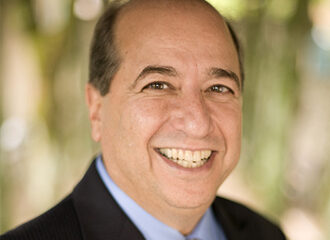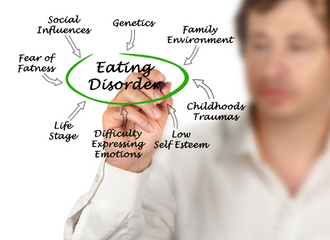Written by: Samantha DeCaro, PsyD
Director of Clinical Outreach and Education, The Renfrew Center
Binge eating disorder is the most common eating disorder in the U.S. and affects millions of people. Here’s everything you should know about it.
 Despite the longstanding myth that Anorexia Nervosa is the most prevalent eating disorder, Binge Eating Disorder (BED) is the most common and affects approximately 3% of adults in the United States.
Despite the longstanding myth that Anorexia Nervosa is the most prevalent eating disorder, Binge Eating Disorder (BED) is the most common and affects approximately 3% of adults in the United States.
BED is a recent addition to the DSM-5, allowing mental health and medical providers to officially diagnose and request funding for the treatment of this condition. When compared to other eating disorders, such as anorexia and bulimia, gender and ethnic differences seem to be much less pronounced.
What Are the Signs & Symptoms of Binge Eating Disorder?
An individual with BED experiences recurrent episodes of binge eating, which means they report eating a very large amount of food in a discrete period of time (i.e., about 2 hours or less).
These episodes must occur for at least once a week for 3 months (mild) but can be as extreme as 14 times a week or more. Currently there aren’t any caloric guidelines to clearly define a binge episode, however, an objective binge episode involves a significantly larger amount of food than what most people would eat in a similar timeframe.
In addition, 3 or more of the following must be present for a BED diagnosis:
- Eating much more rapidly than normal
- Eating until uncomfortably full
- Eating large amounts of food when not physically hungry
- Eating alone because they feel embarrassed by how much they are eating
- Feeling disgusted with oneself, depressed or guilty after the binge episode
How is Binge Eating Disorder Diagnosed?
If you suspect you might have BED, a thorough assessment by a qualified eating disorder provider, such as a licensed therapist, psychologist, psychiatrist, or primary care physician (PCP) would be necessary to confirm a diagnosis and recommend a level of care that best matches your needs.
The assessor will likely ask questions about:
- Frequency & severity of binge eating episodes
- Medical and Psychiatric Treatment History
- Current Medical Issues and Medications
- Substance Use
- Current living situation and support system
- Co-occurring disorders such as anxiety, PTSD, ADHD, bipolar disorder, and/or depression
- Family History
- Safety Issues
- Level of functioning in daily life (e.g., school, work)
In addition, the assessor might also request that you complete a questionnaire or other screening tools. For example, the Eating Disorder Examination (EDE) and the Eating Disorder Examination Questionnaire (EDE-Q) are both trusted assessment tools for BED and other eating disorders. The EDE is administered by a professional, while the EDE-Q can be completed alone.
How is Binge Eating Disorder Treated?
Depending on the severity and duration of BED symptoms (and a variety of other medical and psychological factors), an appropriate level of care will be recommended after assessment. Levels of care can range from weekly appointments with an outpatient team, an intensive outpatient program (IOP), a partial hospitalization program (PHP), a residential program (RES), or in very severe cases, an inpatient hospitalization setting (IP).
The types of therapeutic services might include individual therapy, family therapy, group therapy, art therapy, movement therapy, or a combination of the above.
An eating disorder treatment team usually consists of a therapist, a dietician, a PCP, and a psychiatrist (if any medication management is needed). The multidisciplinary treatment team should be actively collaborating, assessing progress, and targeting the various medical, nutritional, and psychological factors at play.
How Can Nutritional Support Aid Recovery?
An important part of the work in BED recovery includes learning how to consistently nourish the body, meet its metabolic needs, and consume a wide variety of foods. There are no foods that are considered “bad” or “forbidden” in binge eating disorder recovery (excluding any allergies or medical issues). Additionally, eating meals and snacks on a predictable schedule helps to re-establish hunger and fullness cues.
Many individuals with eating disorders have difficulty tuning into their body’s inner world; introducing structure and mindfulness at mealtimes strengthens the connection between the brain and the body. A registered dietician can provide education around the types of irregular eating that maintain the binge eating (e.g., delayed eating, dieting/restricting, and dividing food into “good” and “bad” categories) and help design a meal plan to interrupt the cycle.
The nutritional aspect of BED treatment can be particularly challenging for folks who report difficulty accessing adequate food, and research suggests that those impacted by food insecurity experience increased risk of binge eating and other forms of disordered eating. Treatment providers should assess their clients for food insecurity, educate clients about available federal nutrition programs (SNAP, WIC, TANF, etc.), and provide lists of local resources (food banks, soup kitchens, pantries, congregate meal sites, etc.).
What About the Emotional Work?
Eating disorders are not just about food; they are emotional disorders and BED is no exception. Eating disorder symptoms, such as binge eating, can serve the function of dampening, distracting, or avoiding distressing emotional experiences. An effective treatment approach should help clients mindfully observe their behavioral patterns, improve emotional tolerance, and master the ways they choose to respond to their feelings.
Renfrew’s treatment model teaches the skills needed to navigate even the most frequent and intense and emotional experiences and binge eating urges. By learning and practicing these skills, many discover that they no longer need to turn to binge eating to manage emotions. Other parts of the emotional work might include processing unresolved trauma, participating in fear food exposures, deepening connections with others, improving communication, identifying core values and passions, and discovering – or re-discovering – one’s authentic identity separate from weight or appearance.
The Role of Diet Culture & Oppressive Systems
Social justice work cannot be separated from the treatment of BED. It is extremely difficult, if not impossible, for people to feel safe in their bodies while living in a culture rife with ageism, racism, weight stigma, and fat phobia. At the root of BED, we often find restriction and the intentional pursuit of weight loss as an attempt to mitigate the harm of these oppressive forces.
Diet culture also pushes the false promise that a smaller body will consequently result in a healthier one. Meanwhile, the alleged “cure” of weight loss ultimately becomes the disease; there is mounting evidence that the stress of chronic dieting, weight cycling, and weight discrimination cause tremendous harm both medically and psychologically including, but not limited to, an increased risk of mortality.
Until these systems are dismantled, teaching body neutrality can be a helpful concept as it encourages a non-judgmental approach to our bodies as they exist today. The term reminds us that we do not have to think positively about our body to respect it, to nourish it, to listen to its cues, or to appreciate what it can do for us.
Body neutrality can be a helpful approach when treating binge eating disorder and body image disturbances, as it creates the space to cultivate an authentic identity that places less thought and energy on the physical self and more value on deeply meaningful qualities and traits. Body neutrality can also decrease the guilt and shame associated with having a “bad body image day” or feeling frustrated with your body while existing in a pathological culture.
Conclusion
BED is associated with low quality of life, depression, poor body image, and low self-esteem, but recovery is possible for those who are fortunate enough to access care. The treatment plan for BED should be highly individualized and should occur at a level of care that best matches both the medical and co-occurring psychological issues. A thorough assessment by a qualified eating disorder provider is the first step on this journey to receive an official diagnosis and review the available options.


